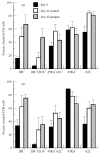Th1/Th2 cytokine responses following HIV-1 immunization in seronegative volunteers. The AIDS Vaccine Evaluation Group
- PMID: 9486388
- PMCID: PMC1904920
- DOI: 10.1046/j.1365-2249.1998.00486.x
Th1/Th2 cytokine responses following HIV-1 immunization in seronegative volunteers. The AIDS Vaccine Evaluation Group
Abstract
The Th1/Th2 profile that follows human vaccination may profoundly influence the subsequent course of disease after infection. However, the ability to detect IL-4 has been limited outside trials of live vaccination. By using methods in which memory effector cells are allowed to antigenically expand by short term culture, followed by low-dose mitogenic stimulation, we have been able to follow the Th1/Th2 profile in HIV-1 volunteers enrolled in two phase I studies of HIV immunogens (a recombinant gp120 and a multivalent, octomeric V3 loop peptide). Antigen-specific interferon-gamma (IFN-gamma) could be detected in primary stimulation, but IL-4 was observed only after antigenic expansion and restimulation. In both of these studies the responses after initial immunizations were dominated by IFN-gamma, with IL-4 appearing only after multiple rounds of immunization, and IL-4 was temporally related to antibody production. Concomitant with the IL-4 production, the amount of supernatant IFN-gamma declined. Antigen-specific IL-10 was not detected in either study. Such techniques, which have been shown to correlate with outcomes in immunotherapy, may prove useful as future surrogates of human vaccine response.
Figures






Similar articles
-
Cytokine responses to human immunodeficiency virus type 1 (HIV-1) induced by immunization with live recombinant canarypox virus vaccine expressing HIV-1 genes boosted by HIV-1(SF-2) recombinant GP120.Vaccine. 2001 Feb 8;19(13-14):1806-19. doi: 10.1016/s0264-410x(00)00378-9. Vaccine. 2001. PMID: 11166906 Clinical Trial.
-
Cytokine profiles in seronegative volunteers immunized with a recombinant canarypox and gp120 prime-boost HIV-1 vaccine. NIAID AIDS Vaccine Evaluation Group.AIDS. 2000 Jul 7;14(10):1365-74. doi: 10.1097/00002030-200007070-00009. AIDS. 2000. PMID: 10930151
-
CD4 T-helper cell cytokine phenotypes and antibody response following tetanus toxoid booster immunization.J Immunol Methods. 2013 Apr 30;390(1-2):18-29. doi: 10.1016/j.jim.2013.01.001. Epub 2013 Jan 11. J Immunol Methods. 2013. PMID: 23318779
-
[Progress of study on Th1/Th2 balance related to research on traditional Chinese medicine].Zhong Xi Yi Jie He Xue Bao. 2004 Mar;2(2):149-51. doi: 10.3736/jcim20040224. Zhong Xi Yi Jie He Xue Bao. 2004. PMID: 15339484 Review. Chinese. No abstract available.
-
The Influence of Antidepressants on the Immune System.Arch Immunol Ther Exp (Warsz). 2019 Jun;67(3):143-151. doi: 10.1007/s00005-019-00543-8. Epub 2019 Apr 29. Arch Immunol Ther Exp (Warsz). 2019. PMID: 31032529 Free PMC article. Review.
Cited by
-
Safety and immunogenicity of an rAd26 and rAd5 vector-based heterologous prime-boost COVID-19 vaccine in two formulations: two open, non-randomised phase 1/2 studies from Russia.Lancet. 2020 Sep 26;396(10255):887-897. doi: 10.1016/S0140-6736(20)31866-3. Epub 2020 Sep 4. Lancet. 2020. PMID: 32896291 Free PMC article. Clinical Trial.
-
The Significance of Interferon-γ in HIV-1 Pathogenesis, Therapy, and Prophylaxis.Front Immunol. 2014 Jan 13;4:498. doi: 10.3389/fimmu.2013.00498. eCollection 2014 Jan 13. Front Immunol. 2014. PMID: 24454311 Free PMC article. Review.
-
HLA class I-restricted cytotoxic T-cell epitopes of the respiratory syncytial virus fusion protein.J Virol. 2000 Nov;74(21):10240-4. doi: 10.1128/jvi.74.21.10240-10244.2000. J Virol. 2000. PMID: 11024156 Free PMC article.
References
-
- Cease KB, Berzofsky JA. Toward a vaccine for AIDS: the emergence of immunobiology-based vaccine development. Annu Rev Immunol. 1994;12:923–89. - PubMed
-
- Sztein MB, Wasserman SS, Tacket CO, et al. Cytokine production patterns and lymphoproliferative responses in volunteers orally immunized with attenuated vaccine strains of Salmonella typhi. J Infect Dis. 1993;170:1508–17. - PubMed
-
- Ward BJ, Griffin DE. Changes in cytokine production after measles virus vaccination: predominant production of IL-4 suggests induction of a Th2 response. Clinic Immunol Immunopathol. 1993;67:171–7. - PubMed
-
- Romagnani S. Induction of TH1 and Th2 responses: a key role for the ‘natural’ immune response. Immunol Today. 1992;13:379–81. - PubMed
Publication types
MeSH terms
Substances
Grants and funding
LinkOut - more resources
Full Text Sources
Medical

